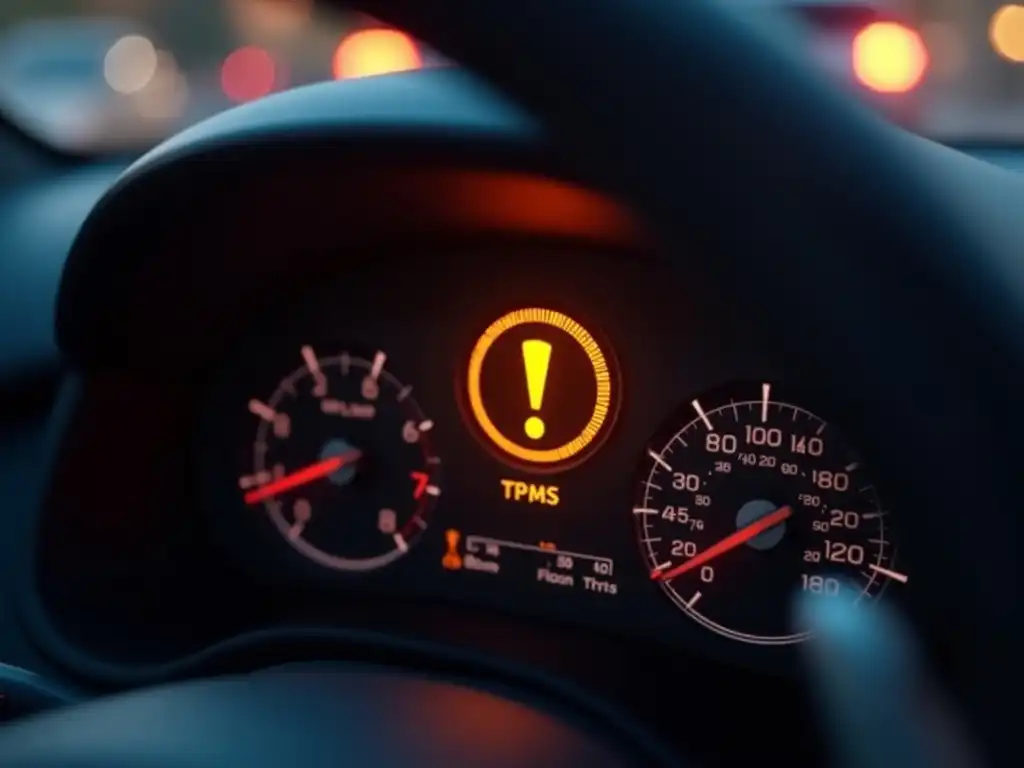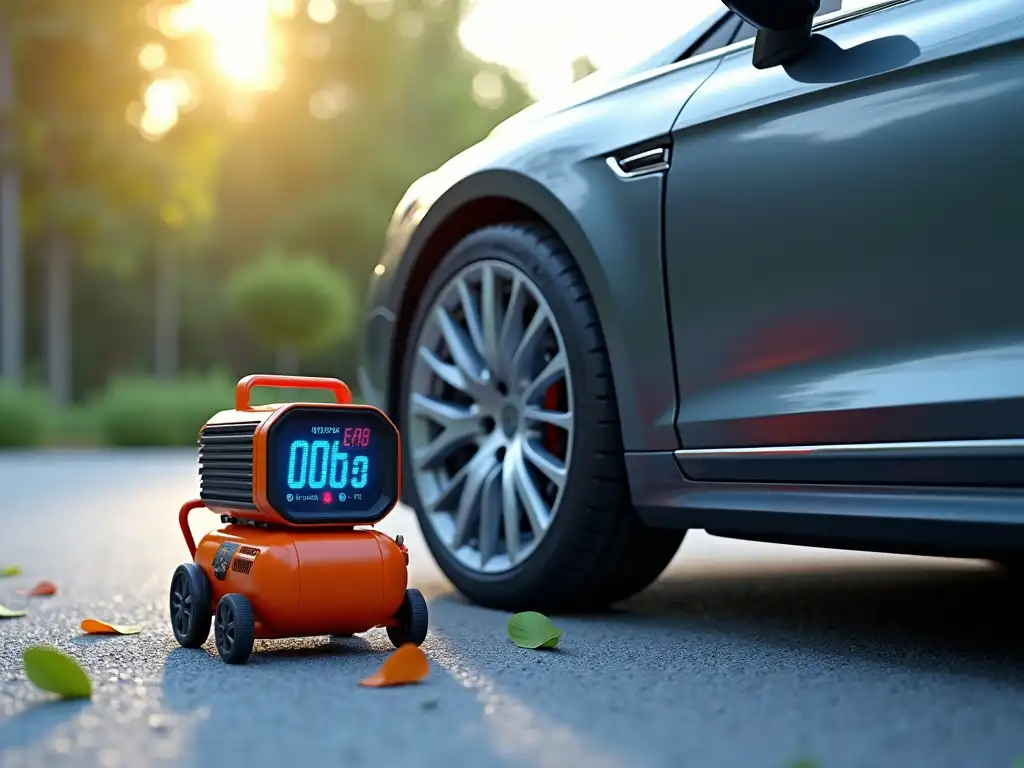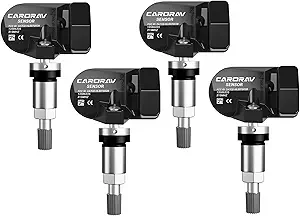So your TPMS light just came on.
First thought: “Great. What now?” Maybe you tapped a curb too hard. Maybe it’s just cold out. Or maybe worst-case scenario, you’ve got a nail in your tire and it’s slowly going flat while you Google “TPMS” in a panic.
Here’s the truth: I’ve fixed this crap for almost two decades. Half the time, it’s a lazy sensor or a tire that’s 3 PSI low. The other half? Yeah, you might be screwed. But before you waste $100 at the dealership, let’s figure out which one you’re dealing with.
Table of Contents
What Is the TPMS Light Meaning? (And Why You Shouldn’t Ignore It)
You know that yellow warning light that looks like a flat tire with an exclamation mark? The one that always seems to come on at the worst possible time? That’s your TPMS (Tire Pressure Monitoring System) waving a red flag about your tire pressure.
Here’s the deal – this isn’t one of those “check engine” lights you can ignore for weeks. I’ve seen too many drivers roll into my shop with destroyed tires because they thought that little light was just being dramatic. The scary truth? According to safety studies, driving on tires just 25% underinflated makes you way more likely to have a blowout or lose control.
The light might blink at first, then stay on solid. It might come and go with temperature changes. But here’s what I tell all my customers: When TPMS speaks, you should listen. It’s not just about saving money on gas (though that’s a nice bonus) – it’s about keeping you safe on the road.

Why That TPMS Light Won’t Stop Bugging You
Alright, let’s figure out why your dashboard is giving you the silent treatment with that glowing tire light. In my 17 years turning wrenches, here’s what usually causes it:
“But my tires look fine!” Yeah, I hear that all the time. Truth is, even slightly low pressure – especially when the temperature drops – can trigger it. That air inside your tires? It gets lazy when it’s cold and contracts, dropping your pressure.
Sometimes it’s not even your tires’ fault. Those little sensors in each wheel? They’re like moody teenagers – eventually they stop communicating properly. Batteries die, corrosion sets in, or they just give up after years of service.
Had your tires rotated or replaced recently? The system might just be confused. And if you live somewhere with real winters (looking at you, Canada and northern states), you’ll probably see this light more often than you’d like. For every 10°F drop, you lose about 1-2 PSI – just enough to make your car start nagging you.
Can You Drive with the TPMS Light On? (The Truth No One Tells You)
Look, I get it – you’re running late, it’s raining, and now your Hyundai’s dashboard is yelling at you about tire pressure. Technically? Yeah, your car will still move. But here’s what they don’t tell you:

If it’s actually low pressure (especially common in Hyundai/Kia models with their sensitive TPMS systems), you’re basically grinding your tire shoulders into hamburger meat. I’ve seen too many Toyota Camrys and Ford F-150s come into the shop with $800 tire damage because someone ignored that light for “just a few more days.”
Now, if it’s just a sensor acting up (common in older GM vehicles), you’re not in immediate danger – but you lose your early warning system. It’s like driving with your check engine light on; you won’t know when a real problem pops up.
Here’s what I actually do with my own cars:
- Find the next safe spot to pull over (gas station, parking lot)
- Grab a $5 pressure gauge (or use the air pump’s built-in one)
- Check all four tires – don’t forget the spare in SUVs like Jeep Grand Cherokees!
- If they’re all good? Make a mental note to get the sensors checked next oil change
Pro tip: Many newer Hondas and Subarus will actually show you individual tire pressures in the dash display – use that feature if you’ve got it!
How to Actually Fix That Annoying TPMS Light (From a Mechanic Who’s Done Hundreds)
Let me break this down the way I would for my neighbor asking for help in my driveway:
Scenario 1: Your Tires Just Need Air

(Most common fix – especially with temperature swings)
Grab your tire gauge (or borrow one from AutoZone – they’ll usually lend it for free). Check each tire against the sticker inside your driver’s door jamb (on your Honda Civic) or fuel door (like many Ford trucks).
Here’s a trick most people miss: The “recommended” pressure is for cold tires. If you’ve been driving more than 15 minutes, add 2-3 PSI to account for heat expansion. I keep a portable compressor in my Chevy Silverado – best $40 I ever spent.
Scenario 2: It’s Probably a Bad Sensor

(Especially common in older Toyotas and Nissans)
If you’ve properly inflated all four tires and the light won’t shut up:
- Swing by any decent tire shop (Discount Tire will usually scan it for free)
- Ask them to check which sensor is dead (usually the battery croaks after 5-7 years)
- Budget about $85-$120 per wheel at a local mechanic (dealerships will charge nearly double)
Warning: Some European cars (looking at you, BMW) require special programming tools even after sensor replacement. Don’t get caught paying stealership prices – call an independent Euro specialist first.
Bonus Tip: Many newer Hyundais and Kias will reset the light automatically after you’ve driven a few miles at proper pressure. Give it 10-15 minutes of highway driving before panicking.
Finding That Elusive TPMS Reset Button (A Mechanic’s Guide)
You know what’s more frustrating than the TPMS light coming on? Trying to find the dang reset button! After resetting hundreds of these systems, here’s where manufacturers like to hide them:
- Toyota/Lexus: Usually under the dash near the hood release
- Ford F-150: In the menu system (because why make it easy?)
- Honda CR-V: Glove box (but only on certain model years)
- Chevy Silverado: Sometimes behind the fuse panel cover
Here’s how I do it in my shop:
- First, actually fill ALL tires to spec (don’t skip the spare in SUVs!)
- Turn the key to “ON” but don’t start (like you’re checking engine codes)
- Feel around under the dash – it’s often a tiny button you’d miss if you weren’t looking
- Hold it until the light does its little blink-dance (usually 3 flashes)
- Take it for a real drive – not just around the block
Reality Check: Your neighbor’s 2012 Camry might have a button, but your 2023 RAV4 probably needs a dealer tool or a complicated menu dive. And European cars? Forget about it – my buddy’s BMW requires a $300 scanner just to reset TPMS.
Pro Tip: Keep your owner’s manual in the glove box. I know, revolutionary idea – but you’d be surprised how many people come to my shop when the answer was right there in page 137.
TPMS Headaches With Old Cars & Custom Wheels (From a Mechanic Who’s Cursed at Many)
Let me tell you about the time a customer brought in his sweet ’98 Mustang with shiny new rims… and a permanently lit TPMS light. This happens way more than you’d think when mixing old cars or aftermarket wheels with modern TPMS systems.
The Cold Hard Truth:
- That sweet set of Fuel Off-Road wheels for your Silverado? Might not have sensor pockets
- Your classic ’72 Chevelle? Probably wasn’t designed with TPMS in mind
- Even some “TPMS-ready” wheels need special valve stem adapters
What I Tell My Customers:
- Always ask about TPMS compatibility BEFORE buying wheels (learned this the hard way)
- Schrader sensors are my go-to – they work in about 90% of retrofits we do
- Expect to pay $50-75 per wheel for decent aftermarket sensors
- Some tire shops (like Discount Tire) include basic sensors with wheel packages
Watch Out For:
- Cheap eBay sensors that fail within months (seen it dozens of times)
- “Universal” sensors that need special programming
- Older BMWs and Mercedes that require dealer tools to recognize new sensors
Pro Tip: If you’re keeping original wheels but just changing tires, reuse your existing sensors – just make sure your installer knows how to handle them properly. I’ve had to replace too many broken ones from careless tire changes.
🚗 TPMS FAQ: Real Answers from a Mechanic (No Fluff)
1. “Hey Siri, will my TPMS light turn off by itself?”
Sometimes! If it’s just cold weather making your tires low, filling them to the right PSI (check your driver’s door sticker) usually makes the light turn off after about 15 minutes of driving. If it’s still on tomorrow, you’ve probably got a leak or dead sensor.
2. “OK Google, can I drive with the TPMS light on?”
Look, I’ve done it too when running late – but only to the nearest gas station. Driving on low tires:
- Wastes gas (costing you $$$)
- Makes your tires wear out 25% faster
- Can cause blowouts at highway speeds
Pro tip: If your steering feels “mushy,” pull over immediately.
3. “Alexa, what’s the lowest safe tire pressure?”
Anything below 26 PSI is danger zone for most cars (your exact number’s on the door jamb sticker). Here’s how to check:
- Get a digital gauge ($10 at AutoZone)
- Measure when tires are cold (before driving)
- Compare to your car’s recommended PSI
4. “How do I add air to my tires?”
Simple steps anyone can do:
- Park near a gas station air pump
- Unscrew the valve cap (don’t lose it!)
- Press the air hose nozzle HARD until you hear air flowing
- Check pressure every 10 seconds with your own gauge
5. “Why does my TPMS light keep coming on in winter?”
Because physics hates your wallet! For every 10°F drop:
- Your tires lose 1-2 PSI
- The light pops on around 25% below recommended pressure
- Morning temps in Chicago/Denver/NYC can trigger this daily
Bonus Pro Tip:
Keep a portable air compressor in your trunk ($35 on Amazon). They pay for themselves in 2 months of not running to gas stations every cold morning.
Final Reality Check on TPMS Lights
After fixing thousands of these warnings, here’s what most drivers don’t realize:
That glowing tire symbol is your first defense against:
• Sidewall blowouts (scary at 65mph)
• $150+ alignment jobs from uneven wear
• Wasted fuel (3% worse mileage = $100+/year)
Every Driver Should:
- Keep a pocket pressure gauge in the glovebox ($8 at Walmart)
- Know their exact PSI (check the door jamb, not the tire)
- Inspect tires monthly – especially before road trips
Real-World Example: Last winter, a customer’s TPMS light came on in their Toyota RAV4. They ignored it for weeks – ended up needing two new $220 tires from driving on 18 PSI.
Your Move:
What’s your TPMS story? Did yours turn out to be simple cold weather or something worse? Share below – I’ll respond to every comment.
Keep Learning:
→ OBD2 Scanner Is Not Connecting? Here’s What You Need to Know
→ Can I Reset an ECU Myself? (Yes, But Read This First)

Pingback: 8 Car Dash Symbols: Meanings, Fixes & Expert Tips